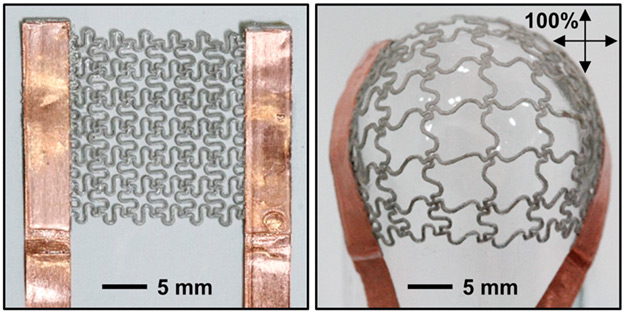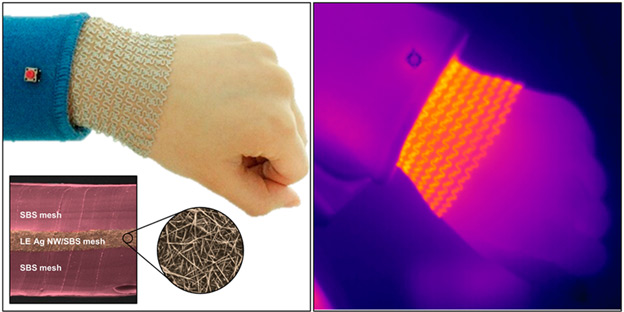| Title of announcement | A Stretchy Mesh Heater for Sore Muscles | ||||
|---|---|---|---|---|---|
| Business forms | Expiration date for bidding | ||||
| Department in charge | 전체관리자 | Registration Date | 2015-07-03 | Hits | 16343 |
| att. | |||||
|
|
|||||
|
A Stretchy Mesh Heater for Sore Muscles
-New flexible, silver-impregnated elastic mesh material is perfect for thermotherapy
July 3, 2105
If you suffer from chronic muscle pain a doctor will likely recommend for you to apply heat to the injury. But how do you effectively wrap that heat around a joint? Korean Scientists at the Center for Nanoparticle Research, Institute for Basic Science (IBS) in Seoul, along with an international team, have come up with an ingenious way of creating therapeutic heat in a light, flexible design.
Other teams have come up with similar devices before, although no one was able to create something that didn’t rely on exotic materials or a complex fabrication process, factors which both carry hefty price tags. Unlike their predecessors, the team at IBS stayed away from things like carbon nanotubes and gold and looked at a more utilitarian option for their build material: thin slivers of silver nanowires.
 (Left: mesh in a relaxed state Right: Mesh stretched over a curve to 100%)
The silver nanowires are tiny, averaging ∼150 nm in diameter and ∼30 μm in length (a human hair ranges from 17 to 181 µm). The nanowires were mixed into a liquid elastic material which is both soft and stretchy when dry.
To ensure that the material remains tight on the target area while heating, the team devised a 2-D interlocking coil pattern for the mesh structure. To make the mesh, the liquid mixture was poured into a shaped mold. The silver-elastic mesh was sandwiched between a top and bottom layer of soft, thin insulation.
In material flexibility tests, while placed on knee and wrist joints, the mesh heated while deformed and under stress on knee and wrist joints. It is lightweight, breathable and generates heat over the entire surface area of the material. A hot water bottle used for treating muscle soreness feels good, but it will inevitably cool down while in use. Commercially available electric heating pads are sufficient for applying heat to an injured area but their cords need to be attached to an A/C outlet to work. This is where the new technology trumps the old. The mesh maintains a constant temperature instead of cooling down during use and is battery powered so it doesn’t need an outlet.
Beyond thermotherapy, the applications are endless. This technology could be used as a lightweight heating element in ski jackets, or as a hyper-efficient seat warmer in a car. Although only flat mesh connected into a tube has been made so far, it isn’t a stretch to imagine creating more intricate designs like the shape of a hand with detailed fingers.
Notes for editors:
- - References Suji Choi, Jinkyung Park, Wonji Hyun, Jangwon Kim, Jaemin Kim, Young Bum Lee, Changyeong Song, Hye Jin Hwang, Ji Hoon Kim, Taeghwan Hyeon, and Dae-Hyeong Kim, (2015), “Stretchable Heater Using Ligand-Exchanged Silver Nanowire Nanocomposite for Wearable Articular Thermotherapy”, American Chemical Society, DOI: 10.1021/acsnano.5b02790
- - Media Contact For further information
or to request media assistance, please contact: Mr. Shi Bo Shim, Head of
Department of Communications, Institute for Basic Science (+82-42-878-8189;
sibo@ibs.re.kr) or Ms. Sunny Kim, Department of Communications, Institute for
Basic Science (+82-42-878-8135; Sunnykim@ibs.re.kr)
IBS was founded in 2011 by the government of the Republic of Korea with the sole purpose of driving forward the development of basic science in Korea It comprises a total of 50 research centers in all fields of basic science, including mathematics, physics, chemistry, life science, earth science and interdisciplinary science. IBS has launched 24 research centers as of January 2015.There are eight physics, one mathematics, six chemistry, seven life science, and two interdisciplinary research centers.
|
|||||
